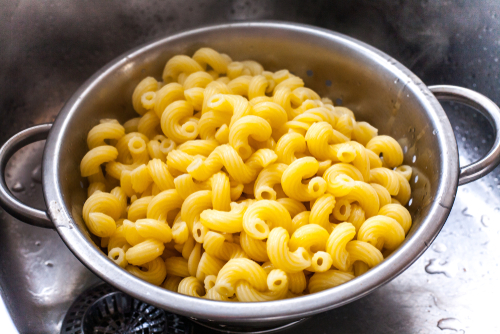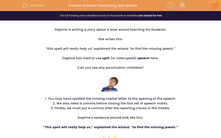Daphne is writing a story about a wise wizard teaching his students.
She writes this:
“this spell will really help us” explained the wizard “to find the missing jewels.”
Daphne has tried to use split (or interrupted) speech here.
Can you see any punctuation mistakes?

1. You may have spotted the missing capital letter at the opening of the speech.
2. We also need a comma before closing the first set of speech marks.
3. Finally, we must put a comma after the reporting clause in the middle.
Daphne’s sentence should look like this:
“This spell will really help us,” explained the wizard, “to find the missing jewels.”

Now, that’s much better.
Now that we have refreshed our knowledge of the first type of split speech, we can look at another way to use split speech.
Using Split Speech to Separate Two Sentences
Take a look at the direct speech below:
“I wonder what we’re having for dinner. I hope it’s pasta,” thought Devina.
Devina says two sentences aloud. We could split the speech between these two sentences and put the reporting clause in the middle.
It would look like this:
“I wonder what we’re having for dinner,” thought Devina. “I hope it’s pasta.”

Can you see how some of the punctuation has changed?
1. We no longer put a full stop after the first sentence in inverted commas as the full stop comes after the reporting clause instead.
2. We use a capital letter when opening the second part of the split speech as it’s a new sentence. If there wasn’t a full stop after the reporting clause, we wouldn't use a capital letter here.
3. We then put a full stop after the final bit of speech as it’s at the end of the sentence and isn’t followed by a reporting clause.
Take a look at the speech below:
“What time is the party tonight? I can’t wait,” exclaimed Theo.

Can you split the two sentences of the speech up and put the reporting clause in the middle?
This would give us:
“What time is the party tonight?” exclaimed Theo. “I can’t wait.”
We still need the question mark after the first sentence to show it’s a question.
We then put a full stop after the reporting clause and after the second sentence of the speech.
In this activity, you’ll be punctuating split speech. There are a lot of rules to remember so check back here if you need to - just click on the red help button on the screen at any point during the activity.







